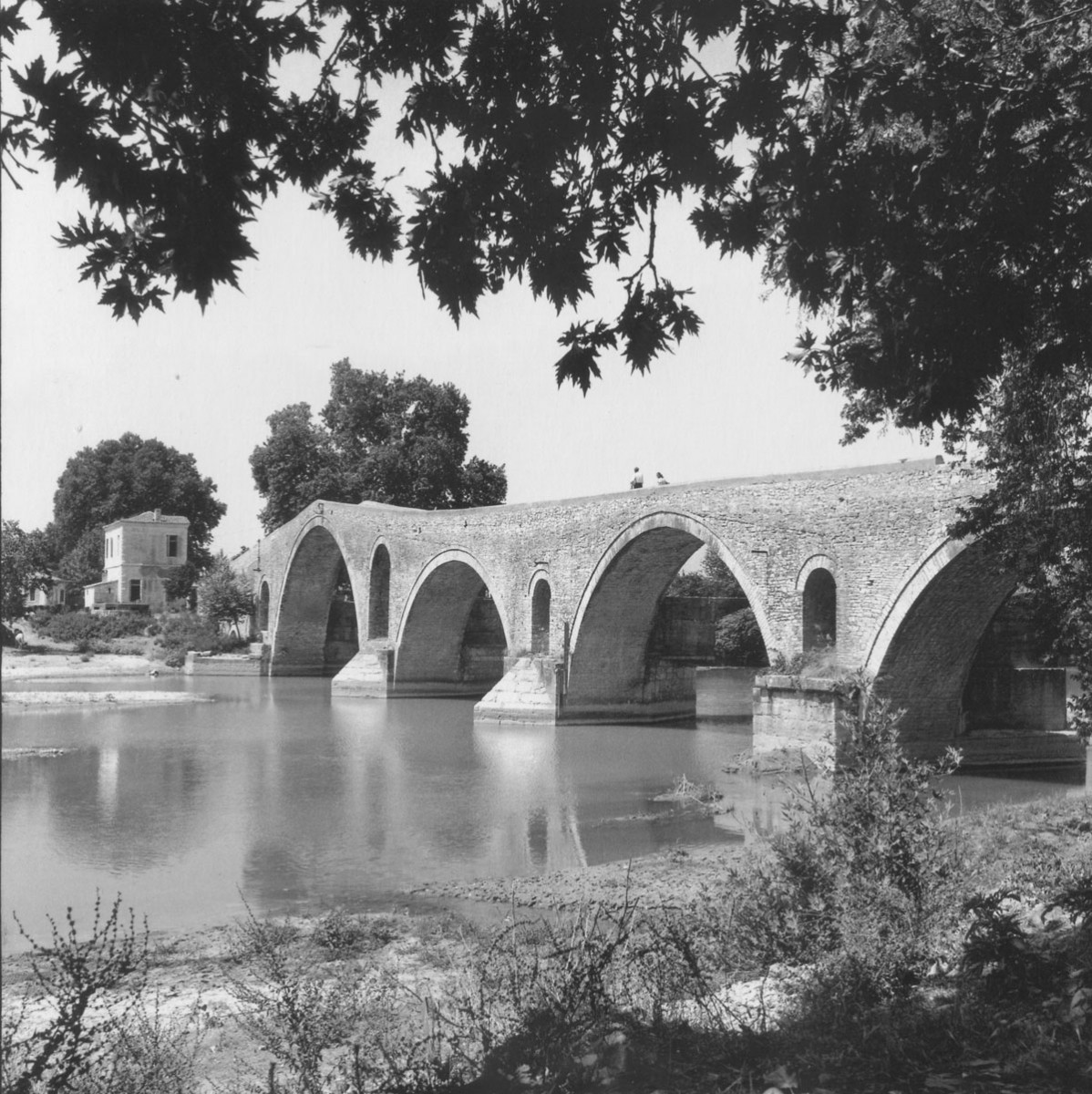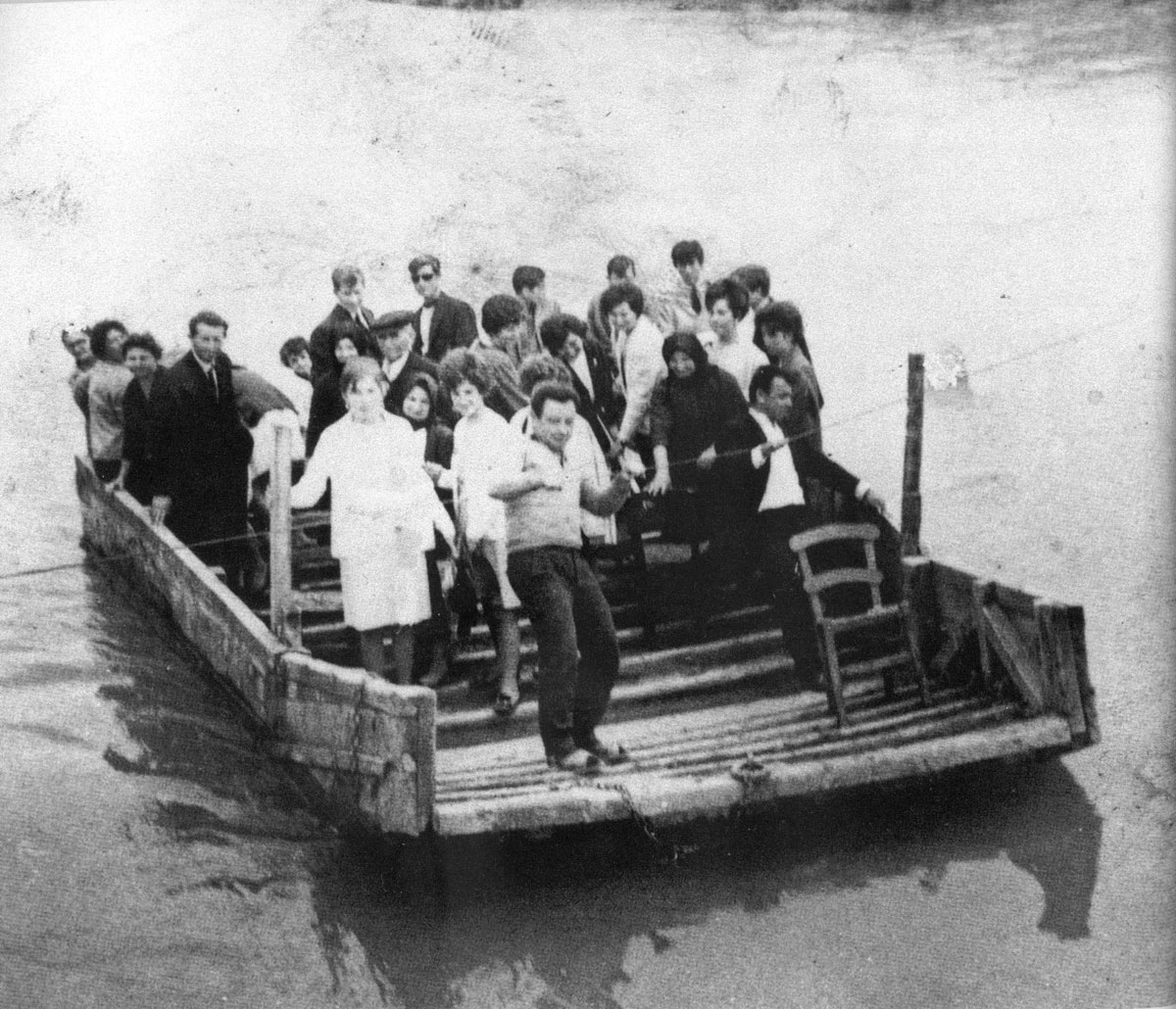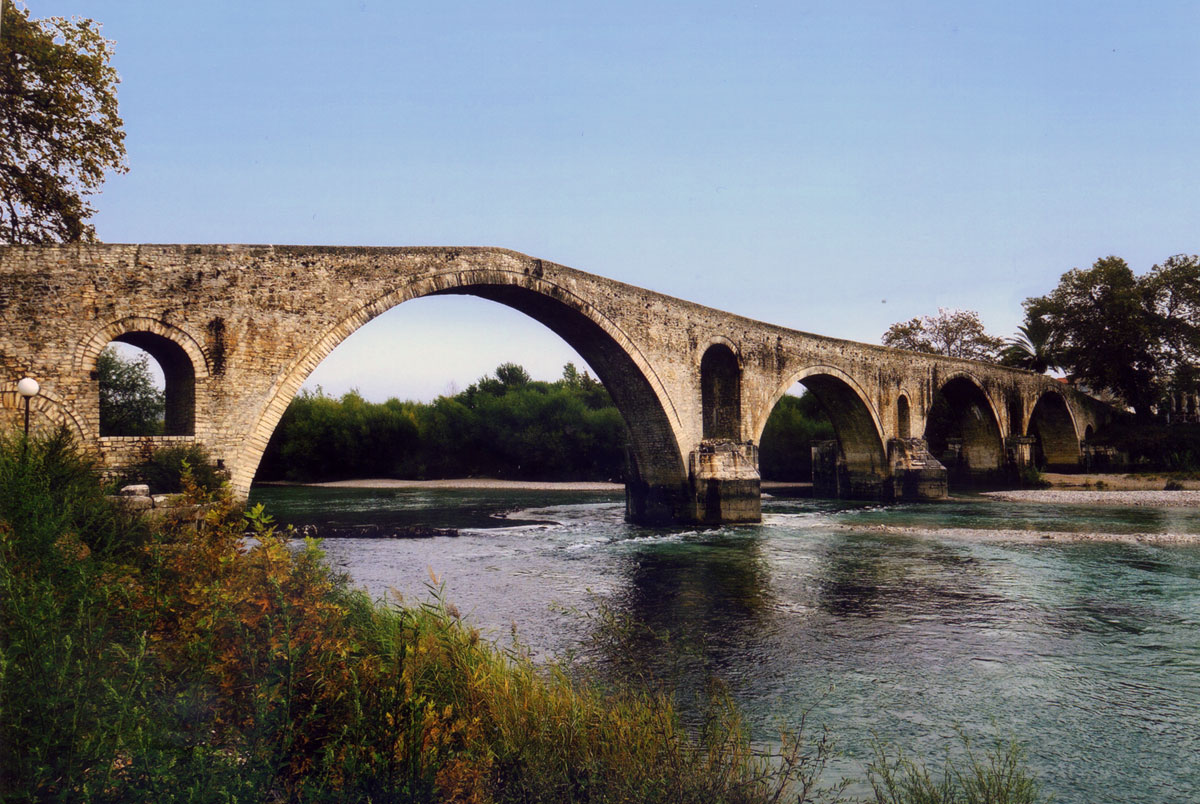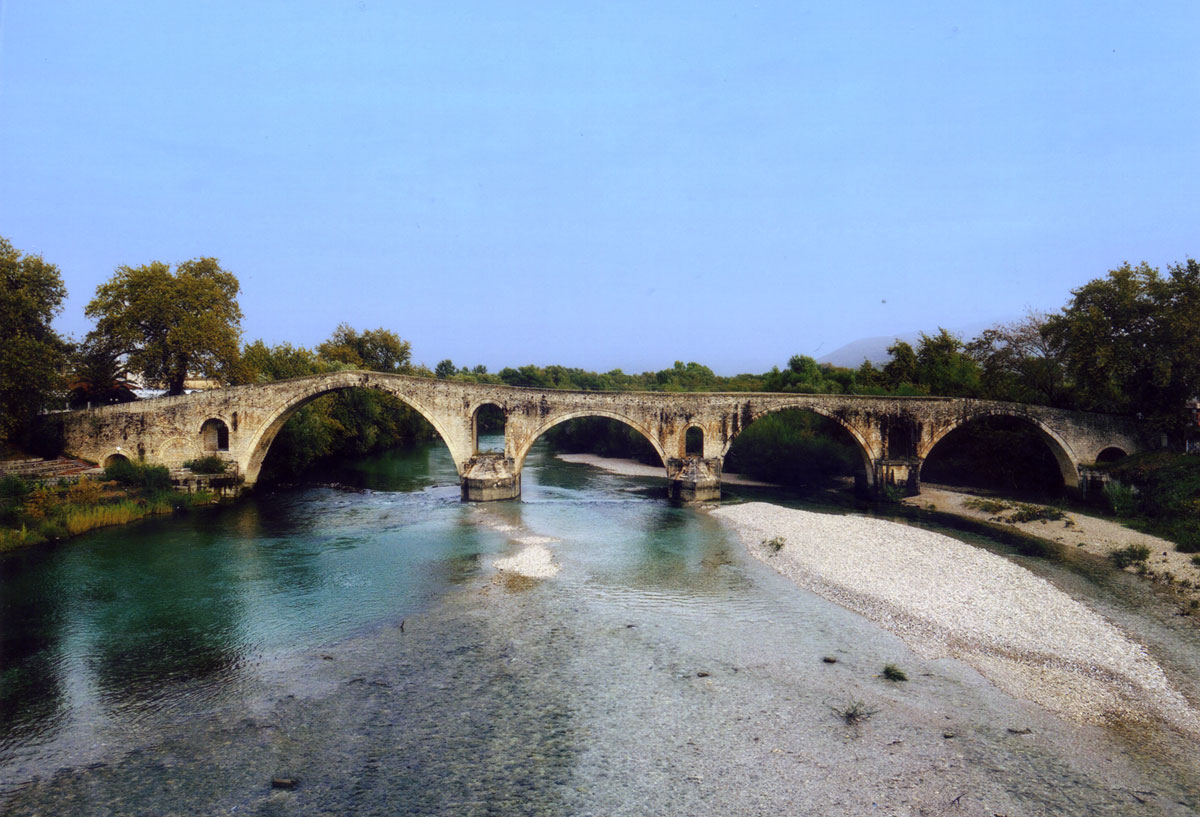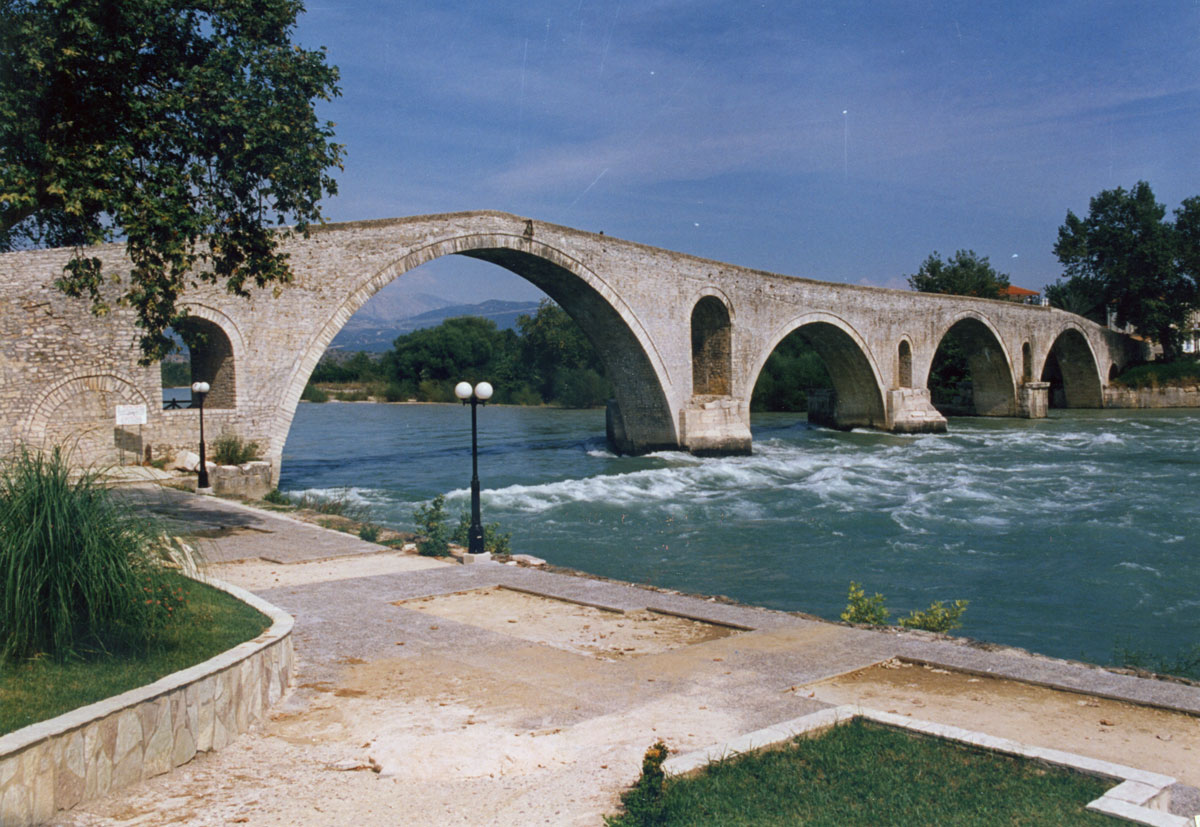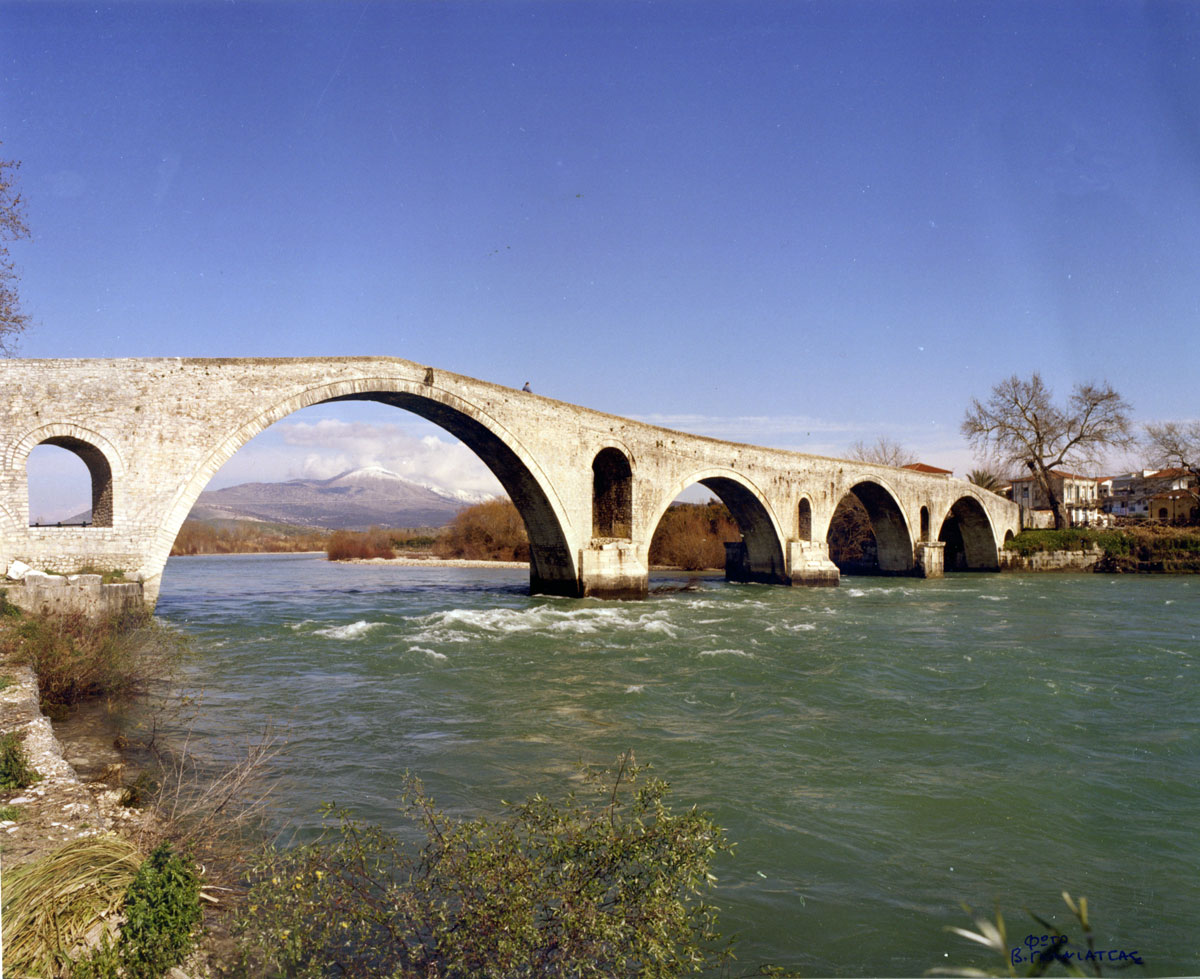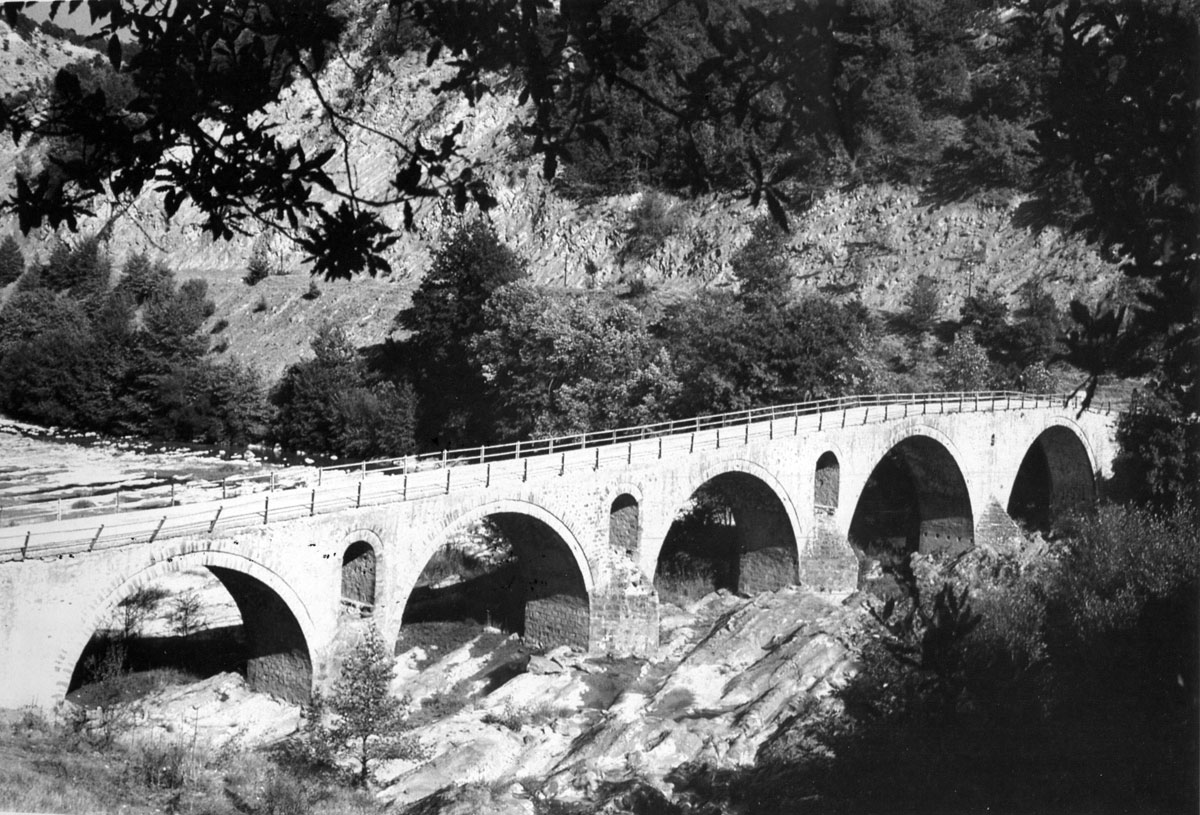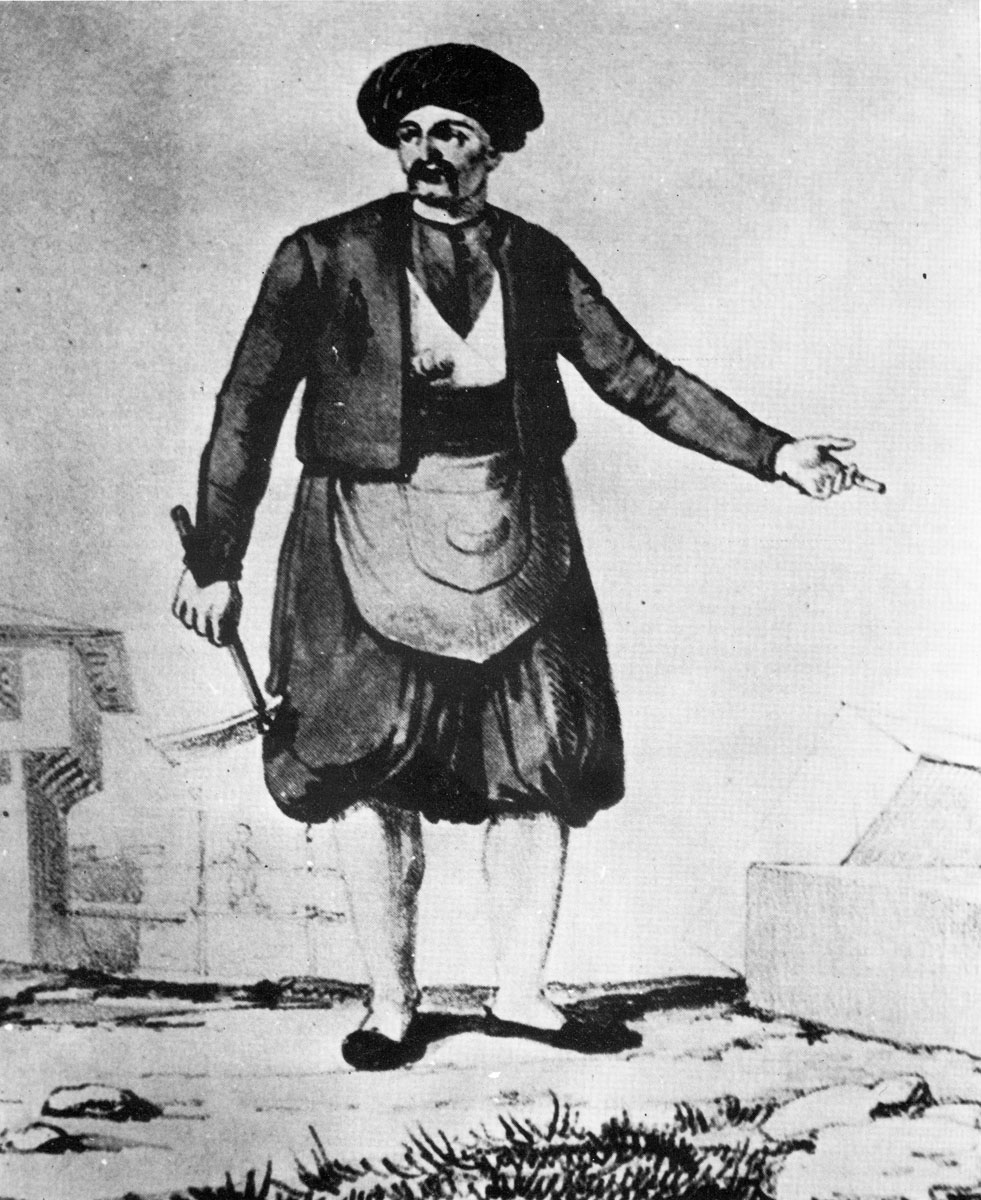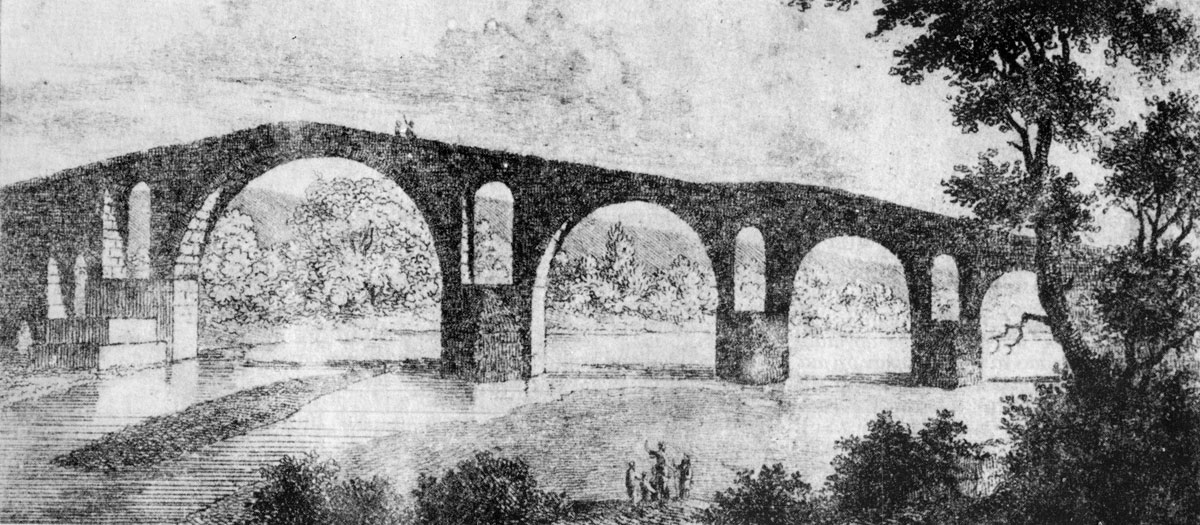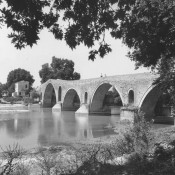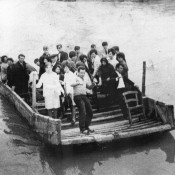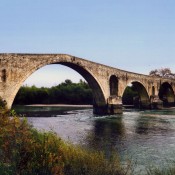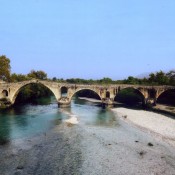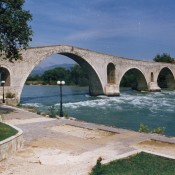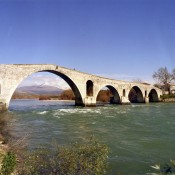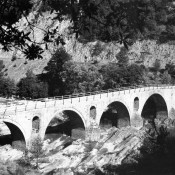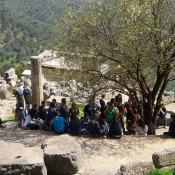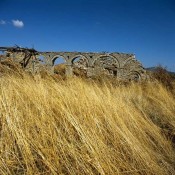“People make churches, they make monasteries as well, they also make stone bridges for people to cross” (note 1)
In the following article, the most famous, perhaps, of all bridges in Greece will be presented as well as its manner of construction and the legends surrounding it (fig. 1). Apart from being an important monument of modern Greek traditional architecture, the bridge of Arta is also a significant landmark of the region.
Since ancient times, the building of bridges had already become necessary for the crossing of rivers, torrents and streams. Bridges were made of wood and stone. Those of stone were more solid and durable while those of wood were temporary and less safe. There were also wooden bridges set on stone pillars connecting the banks of large rivers. Till the mid 20th century, the large rivers were crossed on wooden rafts known as perataries (note 2, fig. 2). Finally, people and beasts of burden crossed rivers at their shallowest point called the “poros” (passage/pass).
All through Turkish rule, Macedonia and mainly Epirus were the birth places of important builders from Northern Greece who made churches, monasteries, mosques, caravanserai, covered market places, stately homes, fountains, mills and houses. The artisans who specialized in building bridges were called kioprouledes after köprü, the Turkish word for bridge. There is plenty of stone to be found all over our country. So everywhere traditional buildings are made of stone.
The architecture of the old stone bridges of Epirus does not differ from that of bridges in Macedonia, Thessaly, Thrace and the Peloponnese. Their main architectural feature is the arch. There are bridges with one arch, two arches or more. The multiple arched bridge of Arta is approximately one kilometre south of the old centre of the modern town. It joins the two banks of the river Arachthos, known in antiquity as Inachos, and is the continuation of the road which connects Arta with its fertile plain (note 3) and with Preveza (fig 3, 4). The bridge is 142 m long and 3,75 m wide. Quite a large section of the bridge, from both ends, has been subsequently silted up, raising the height of the river banks and shrinking the river bed (fig. 5, 6).
The bridge is made up of four large arches and three smaller ones. The arches have different diameters which makes the bridge charmingly asymmetrical. The arches are set on pillars. Above the pillars there are small arched openings in the walls which help to lighten the bridge’s weight and act as openings allowing large amounts of water to flow through should there be a flood. The bridge’s pillars have been built with large regular stones, while the arches and the rest of its superstructure were built with smaller ones without the use of bricks in the joints. The bridge’s paving is cobbled and built on a higher level than the big arch, creating ramps on either side. This construction method is typical of traditional bridges made during the time of Turkish rule (note 4). Some supporting pillars and sections of the bridge, however, have different masonry belonging to a previous phase of construction. As pointed out by A.K. Orlandos (note 5), a possible interpretation of this could be that in the past (note 6), an attempt had been made to span the Arachthos at this particular spot. In other words, the later bridge was founded on the earlier one which had been swept away in one of the frequent floods.
In its present form, the bridge of Arta dates from the first fifteen years of the 17th century, between 1602 and 1612. In his “Essay” (note 7), the scholar and metropolitan of Arta Seraphim Xenopoulos mentions that, according to Anagnostis Gerostathis, the bridge was built in 1602, while he himself believes it was built in 1606. In a “memorandum” (note 8) belonging to Gennadios the metropolitan of Arta, published in 1929 by K. Kairofyllas (note 9), it is written that the bridge was built in 1612.
The craftsmen preferred to build multiple arched bridges, avoiding very high and very wide arches, as in the case of the bridge of Korakas (note 10) which has an arch rising 25 m above the surface of the river Aspropotamos (Acheloos) near the village of Vresthenitsa (known today as Peges) in Arta.
Apart from the bridge of Arta, the most well known multiple arched bridges of Epirus are the following; the four arched bridge of Papastathis on the Arachthos river (note 11), the bridge of Patriarch Joasaph also on the Arachthos (note 12), and the twelve arched bridge of Ahmet Kurt Pasa (note 13) in neighbouring Albania. Two well known multiple arched Macedonian bridges spanning the Venetikos, a tributary of the Aliakmonas, are those of Spanos (note 14) (fig.7) and of Aziz Aga or Zizaga (note 15).
Sponsors funding the building of stone bridges were either rich Greeks (note 16) or Jews (note 17) living in the district, Turkish officials (pashas (note18) or agas), people of the Church (patriarchs, metropolitans, abbots or monks from neighbouring monasteries, priests), bandits and guerrillas, the communities of one or more villages and even brigands (note19).
The old stone bridges were named either after the place they were built, their nearest village or town (the bridge of Arta, Plaka, Konitsa) or after their sponsor (the bridge of the Patriach, of Misios, of the Jew, of Kaberaga, Zizaga, Pasha,Valavanis (note 20)).
According to local tradition written down by the metropolitan Seraphim (note 21) and Nikolaos G. Politis (note 22) the entire cost of building the bridge of Arta was covered by a grocer in Arta, named Giannis Thiakogiannis, known by his nick name Gatofagos, the “Cat eater.’’ According to this tradition, a pirate ship from Algiers brought a cargo of oil to sell at the port of Salaora (note 23). People gathered from the surrounding villages to buy it. Among them was Gatofagos who bought many jars (kapases) full of oil. The pirates sold Giannis Thiakogiannis the goods belonging to a merchant they had robbed. But apart from oil, the jars also contained gold coins in abundance, that the merchant had hidden and the pirates had been unaware of. So the Cat eater got miraculously rich, just like a character out of a fairy tale, having come by a great and mysterious treasure which he then used to build the bridge of Arta.
The collapse of bridges while being built was usually due to poor foundation work, as in the case of the bridge of Arta that had to have its foundations on the plain’s unsuitable loose soil. For the multiple arched bridge of Arta to have strong foundations, the beautiful wife of its master builder was walled up alive (note 24) (fig. 8). According to N.G. Politis’ interpretation, the victim’s soul gained supernatural strength and became the guardian spirit of the bridge, protecting it from all harm. The legend of the bridge of Arta is repeated in the following three Macedonian bridges: the bridge of Morna in Pieria, the bridge of Smixes and the bridge of the Pasha (note 25) (fig. 9). According to N.G. Politis and G.A. Megas, the walling up of a human being in the foundations of a bridge or some other type of building is an ancient Greek and Byzantine custom. Since the prehistoric era, it is also widespread throughout the five continents and, as shown in archaeological finds, originates from real facts. The term “Haunting” was given by the Byzantines to the founding by human sacrifice of important buildings such as castles, aqueducts, churches, fountains, bridges, villages and even entire towns.
Fidaleia, wife of Byzanta, the mythic founder of Byzantium, was sacrificed for the building of the foundations of that city later to be known as Constantinople. An 8th c. byzantine text (note 26), the “Parastaseis Syntomoi Chronikai” informs us that, according to a very old tradition, the ancient statue of Fidaleia protected the walls of Constantinople. For some reason the statue moved and then the ground started to shake. The emperor ordered a litany to take place and the earthquake stopped when prayers were said to Saint Savva (449-532).
All over Greece there are records of 333 variations of the song about Arta. These beliefs are widely spread among other medieval people mainly from South Eastern Europe; Hungarians, Serbs, Bulgarians, Rumanians, Albanians and Vlachs. By demand of the fairy Wila, the Serbs buried two children with the same name, Stoyan and Stoyana, in the foundations of the castle at Skutari. Two brothers were buried alive in the foundations of Strasburg Cathedral.
In Russia, to the west of Baikal, while excavating an 6th/7th century earthen tower, a woman’s skeleton was found at its base. The skeleton’s posture was unnatural. The dead woman had her hands raised to her face and the fingers were bent as if she had torn her face with her nails. According to the excavators, the woman had been buried alive in the tower’s foundations (note 27).
In 1515, “a thousand hornless (sioutes) goats” were sacrificed for the founding of the single arched bridge of Korakas on the Aspropotamos (Acheloos) river, near Vresthenitsa in Arta. According to another version, the river (note 28) is tamed by the construction of the bridge and for it to be completely dominated, it demands as compensation the sacrifice of “noble animals” or of a human.
Traditions concerning human sacrifice are more frequent in cases of very long stone bridges joining river banks to plains and needing to be built on sandy or alluvial soil. There are fewer difficulties when building small stone bridges over mountain streams with rocky banks. Old stone bridges were always built on large or small overland roads, in or outside a settlement. Sources for our information are the structures themselves – especially those that are dated -, old contracts, archives in Greece and abroad, travel writing and illustrations, traditions and their accompanying legends as well as popular building terminology.
In the times of Turkish rule, public works such as bridges were funded by communities (note 29) or rich locals. Very often these works were done as chores.
On the north bank of the Arachthos, next to the bridge of Arta, the great plane tree of Ali Pasha stands to this day. Ali Pasha sat in the shade of this tree and watched, dangling from the branches, the lifeless bodies of those he had condemned to death “by hanging”. Next to the bridge (note 30) there is also an elegant neoclassical building of 1864, designed by an Austrian architect, which used to be a Turkish customs house (note 31). Today this building is the town’s Folklore Museum.
Greek 19th century scholars such as Athanasios Stageirites (note 33), Panagiotis Aravantinos (note 34) and Ioannis Lambrides (note 35) who dealt with the region of Epiros (note 32), refer to the bridge of Arta. 19th century European travellers who visited Epiros, also describe impressions of the bridge of Arta in their writings. It is worth mentioning the following: Captain William Martin Leake from England (note 36), F.C.H.L. Pouqueville the Greek speaking doctor and French consul (note 37), Henry Holland the English doctor (note 38), T. Smart Hughes the classicist (note 39) and William Turner the painter (note 40).
The old stone bridges, made of local building materials, blend in with their natural surroundings. They were built by local or itinerant builders organized in companies (note 41). The builders who attempted long journeys were mainly from Epirus (Koudaraioi) (note 42). They went to the Peloponnese, mainland Greece, Rumania, Egypt and Persia.
In their craft, these itinerant (note 43) popular builders creatively absorbed “foreign and indigenous” elements, following a prototype and its variations, according to a tradition accepted by the society of that period (note 44).
Their creations, the handcrafted, well built and solid stone bridges like the one in Arta, keep intact the memory of another era. They are guarded by the supernatural forces of their “spirits” which protect them from floods (note 45) and the dangers of collapse (note 46).
Αfendra G. Moutzali,
Archaeologist
Glossary
agas, ağa in Turkish: local official, administrative functionary of the Ottoman empire.
Kalderimi, kaldirim in Turkish: possibly adapted from the medieval Greek word kalodromos: cobbled road, cobbled paved surface.
Kapasa: large jar
Kioprouledes: popular craftsmen specializing in the construction of traditional stone bridges. After the Turkish word köprü meaning bridge.
Koudaris is the handyman and koudas is the builder, in the secret language, known as koudaritka or mastorka, of the Koudaraioi, Macedonian and Epirot handymen.
Kourbani: Originates from the medieval Turkish word Kurbân which means a sacrificially slaughtered animal at a muslim celebration. A slaughtered animal at a wedding , a feast or on the corner stone of the foundations of a new building. Phr. They slaughter a sacrificial cockerel or lamb or ox.
Pasas, paşa in Turkish: the title of a functionary of the Ottoman empire who governs a pasaliki (pasalik in Turkish).
Perataria: wooden raft used by people and beasts of burden to cross large rivers from one bank to the other. The man rowing the raft was called the perataris.
Podariko: pous in ancient Greek, podarin in medieval Greek. The bottom part of vertical elements (jambs, pillars, bridges, the sides of a pit).
Poros: passage through the river at its most shallow point.
siouta (goat): without horns
stoicheiose was the term used by the Byzantines for the founding of buildings (castles, aqueducts, fountains, churches, villages and even towns) by sacrificing “noble animals” or humans.
Hyperekheilistes: small arched openings in the walls of old stone bridges that lighten their weight and function as relief holes allowing large quantities of water to flow through them in cases of floods.
Note Abbreviations
A.B.M.E.: Archieion Byzantinon Mnemeion tes Hellados.
Essay: Serapheim Xenopoulos ho Byzantios, Dokimion Historikon peri Artes kai Prevezes, Athens 1884, Arta 2003( 3rd edn.)(reprinted by the “Skoufas” Music and Literary Society of Arta).
E.H.B.S.: Epeteris Hetaireias Byzantinon Spoudon
E.C.: Epirotika Chronika
Τ.Ε.Ε.: Technikon Epimeleterion Hellados (Technical Chamber of Greece).

NOTES
1.
Παπανικολάου Φ., Γλώσσα και λαογραφία επαρχίας Βοΐου, έκδοση Βοϊακής Εστίας Θεσσαλονίκης, Thessaloniki 1973, p. 75.
2.
In earlier times the river Pineios was spanned by wooden rafts/perataries. Κλιάφα, Μ., Άνθρωποι του μόχθου, Θεσσαλία (1920-1980), εκδ. Μεταίχμιο, Athens 2007, p. 96. Photograph of 1961, from the Gerostathis archive, showing the inhabitants of Nome village crossing the Pineios on a raft on their way to the village Pedinos on the other side. See here, fig.2.
3.
Formerly known for its vineyards, the large and fertile plain of Arta surrounds the town, offering its inhabitants plenty of pastures and agricultural products. It was made fertile by silt from the Arachthos and Louros rivers.
4.
Ορλάνδος Α., «Η γέφυρα της Άρτης», Α.Β.Μ.Ε.,vol Β΄ (1936), pp. 195-199.
5.
Ορλάνδος, ibid, p. 196.
6.
In antiquity, in the time of Pyrrhus, in the Roman era or during the Late Byzantine period when Arta was the capital of the Despotate of Epiros.
7.
Ξενόπουλος Σ., Δοκίμιον Ιστορικόν Περί Άρτης και Πρεβέζης, Athens 1884, Αrta 2003, 3rd edition (reprinted), pp. 378-379.
8.
In Post-byzantine years a “memorandum” was, usually, a dated note in a book. The “memorandum” is considered as a historical source because its author, as a rule, had a direct perception of the event he was recording. Incidents of great or small importance are recorded such as: earthquakes, famines, droughts, floods, the siege of cities, raids by barbarians, epidemics, the building of churches, bridges or castles, the construction of aqueducts etc.).These incidents are all experienced by the writer who, in a small corner of a book’s page, expresses his pain, fear, admiration or hopes. In the Byzantine era there were marginal notes, written in the margins of codes with a similar content. Gennadios the metropolitan of Arta “made notes” in the book of “the Teachings” of Elias Meniates (1669-1714) the Preacher from Lexouri, which was kept in the monastery of Kato Panagia in Arta.
9.
Καιροφύλλας Κ., «Ιστορικά σημειώματα περί Άρτης», E.C. 4 (1929), pp. 80-84.
10.
The single arched bridge of Korakas is the largest of its kind in Epiros. It was built in 1515 and connected Petroto (Liaskovo) in Thessaly with Peges (Vresthenitsa) in Arta, also fulfilling the needs of other villages in this mountain district which at that time were densely populated by Greeks due to ”mountain settlements”. The bridge’s construction was funded by Vessarion, the Metropolitan of Larisa (1489-1549). The single arched bridge of Korakas was blown up by the guerrillas in 1949. Μαντάς, Σπ., Τα Ηπειρώτικα Γεφύρια, εκδ. Λαϊκό Πολύπτυχο, Αthens 1984, p. 62, no.15.
11.
It was built in 1746, below the village of Krapse behind the Driskos mountain. Its sponsor was Agapios the abbot of the Vlize monastery. It cost 350 venetian gold coins. Μαντάς, ibid, p. 63.
12.
Below the village Gonista. It was built in 1568. Its sponsor was the Patriarch Joasaph from Krapse. It cost 2.000 silver coins, known as ’’white’’. Μαντάς, ibid, p. 63.
13.
On the river Skoube, near Elbasan in Albania. Built in the year 1778.Funded by Ahmed Kurt Pasa. Μαντάς, ibid, p. 69.
14.
Built in 1727. Its sponsor was Mustafa Aga known as the Beardless, from Argyrokastro/Gjirokastra. It is located between the villages of Kipurgio, Kasimati and Pegaditsa in the Grevena district. It cost 50.000 piastres. It was 84m long and 3,50m wide. It is the longest surviving bridge in Macedonia. Τσότσος Γ., Μακεδονικά γεφύρια, εκδ. University Studio Press, Thessaloniki 1997, pp. 33-37.
15.
It is located southwest of Grevena, between the villages of Trikomo and Kasimati. It is 71m long and its total height is 15m. It has three arches. Since the time of Turkish rule, the Aziz Aga bridge was on the most frequented trade route, linking Epiros with West Macedonia. Caravans from Epiros passed that way going to Central and Eastern Europe. Τσότσος, ibid., pp. 38-39 και fig. 10 on p. 40.
16.
The bridge of Misios, in Central Zagori, between Vitsa and Koukouli, built in 1748. The cost of its construction was covered by Alexis Misios from Monodendri. Zagori, a place name of Slavic origin, means a region behind the mountain. It is a complex of 45 villages, to the North of Ioannina comprising one of the most remarkable traditional building complexes in Greece. As natural and artificial boundaries, it has the river Aoos to the North, the Mitsikelis mountain to the South, as well as the national highway of Ioannina to Metsovo in the East and that of Ioannina to Konitsa in the West. Its landscape is made up of mountains sometimes covered with thick forests or else rocky and steep, divided by ravines and rivers, like the ravine of Vikos through which flows the river Vikos otherwise known as Voidomatis. There is scarcely a plain in Zagori. Here, bridges are an architectural feature of the Epiros landscape. Man, landscape and stone; the implicit grandeur in the Greek people’s craft of building.
17.
The Jew’s double arched bridge, built in 1806, on the Xeropotamos river in Central Zagori. The price of its construction was covered by Solomon Matsilis, a Jew from Ioannina.
18.
The Pasha’s bridge, built on the Aliakmon river, very near the National Highway of Kozani to Grevena, at the spot known as “Soubino”. Mahmut Pasha built it in 1690. According to popular tradition, as recorded by Demetris Loukopoulos, the Pasha’s bridge kept being built only to collapse, so the master builder had his wife walled up in the bridge’s foundations to make it secure. Λουκόπουλος Δ., Λαογραφία, volume 6, (1917), pp. 114-115. Τσότσος, ibid, pp. 58-62.
19.
In 1854, the brigand Nikolaos Zambros from Polyneri in Grevena, paid for the building of the Moirales (today’s Chrysavghe) bridge in Vaios, Kozani, because the district’s population did not hand him over to the Turkish detachments pursuing him. Τσότσος, ibid., p. 86.
20.
The Valavanis bridge on the river Alpheios in Peloponnesus, named after the Member of Parliament who saw to its construction. According to the inscription «Ο ΤΕΚΤΩΝ ΑΝΤ. ΚΑΤΣΑΙΝΟΣ 1880», it was built in 1880 by Antonis Katsainos the master builder from Langadia.
21.
Ξενόπουλος, Δοκίμιον..., ibid, p. 379.
22.
Πολίτης Ν., Μελέται περί του βίου και της γλώσσης του ελληνικού λαού. Παραδόσεις, volume Α΄, Αthens 1904, p. 95, no. 169.
23.
Salaora, port of Arta in an inlet of the Ambrakikos gulf. At the time of Ali Pasha Tepenleli (1788-1822) it was the beginning and end of an overland road of great strategic and commercial importance, that went as far as Ioannina. Salaora means Sal-agora, the salt market, after the salt mines of the Amvrakikos, like those of Kopraina and St Nikolaos at Vonitsa.
24.
Πολίτης Ν., Εκλογαί από τα τραγούδια του ελληνικού λαού, Αthens 1932, 3rd edition, p. 131, no 89 and 179. Μέγας Γ., «Το τραγούδι του γεφυριού της Άρτας», Συγκριτική μελέτη, Λαογραφία, volume 27 (1971), pp 24-212 and especially pp. 33, 35, 147, 172. Οικονομίδης Δ., «Η θυσία εις οικοδομήματα», Ε.H.B.S 45 (1981-1982) pp. 43-132. Αικατερινίδης Γ., Νεοελληνικές Αιματηρές Θυσίες. Λειτουργία – Μορφολογία – Τυπολογία, Αthens 1979 (Λαογραφία Appendix no. 8). By the same, Εθιμολογικά ελληνικής λαϊκής οικοδομίας, ΑΡΜΟΣ - An Special volume on Professor N.K.Moutsopoulos in honour of his 25 years of service to the Polytechnic School of the Aristotelian University of Thessaloniki. Department of Architects, volume A’ (1990), pp. 147-166 and especially pp. 147, 149-159 και 163. The primary building phase of the putting down of foundations is accompanied by acts both utilitarian and superstitious in content. The main custom in building is the sacrifice of animals, known as the kourbani. The animal usually sacrificed in the house’s foundations is a cockerel or a hen. Also mentioned are lambs, goats, rams and oxen. Following a blessing with holy water by the priest, the animal is slaughtered on the foundations’ cornerstone. The sacrifice’s real purpose stems from a primordial belief that in this way the building acquires a guardian spirit that can remove any danger and evil from it. In this belief, mention is made both of ancient myths and Byzantine traditions about human sacrifice during the founding of great buildings. At a more advanced stage of mankind’s civilization, human sacrifice was replaced by animal sacrifice, which was done for the same reason; the stabilizing and protecting of a building. The song about the “Bridge of Arta” resonates with memories of earlier human sacrifices which however were not unknown in later times. The song is widely spread throughout South Eastern Europe and has been studied internationally for over a century. A prominent and realistic memory of human sacrifice is presented in the belief widely prevailing today that if soil used for the foundations includes the footprints of an unsuspecting passer by or if, more importantly, someone’s shadow is put in the foundations, this person will die shortly. Each house has its spirit. The soul of the sacrificed animal took on various spirit forms. It transformed into a negro, a ram, a cockerel and very often a house snake. It is the revival of the ancient Greek worship of the οικουρού όφεως (house serpent). Ρωμαίος Κ., «Το φίδι του σπιτιού. Νεοελληνικές επιβιώσεις της λατρείας του οικουρού όφεως», Λαβύρινθος 1 (1973-1974), pp. 50-64. Blessing with holy water performed by the priest in the newly built house, is also part of preventive rites against evil.
25.
Τσότσος, Μακεδονικά γεφύρια, ibid., pp. 25, 58, 59.
26.
Cameron A. / Herrin J., Constantinople in the early Eighth Century: The Parastaseis syntomoi chronikai, Leiden 1984, chapter. 4, pp. 58-60, 171.
27.
Vargyas Lajos, Researches into Medieval History of Folk Ballad, Akadémiae Kiadon editions, Budapest 1967, chapter ΙΙΙ, pp. 173-233: «The origin of walled-up wife».
28.
In ancient Greece rivers were sacred. Each river had its own god. These gods were depicted in the form of a bull or as a bull with a human head. One such form was called Acheloos , like the large river in North West Greece. We do not know if the god of the Acheloos river was a river deity or if at that time the word Acheloos meant water. River demons in the shape of a bull were also known in popular European traditions. The ancient Greeks asked the river to help not only the soil but humans also to become fertile. Names related to rivers, such as e.g. Kefisodotos, were common after the 6th century. Nilsson Martin, Ελληνική Λαϊκή Θρησκεία, transl. Ι.Θ. Κακριδής, Αthens 1979, pp. 8, 9.
29.
The church and its square are an expression of the community along with fountains, wells and irrigation canals, bridges and roads inside and outside the settlement. There were also facilities that made a profit such as wind mills, oil presses, water mills and inns that were either owned privately or by monasteries and were used by the population.
30.
The bridges’ ancillary buildings were usually small watch towers (koulies), wind mills and inns.
31.
Arta, the old capital of the Despotate of Epiros, known by that name since 1082, was built on the left bank of the Arachthos river, it was spread out amphitheatrically on the lower slopes of the Peranthe (Valaoras) hill and occupied the position of ancient Amvrakia. It surrendered to the Ottomans on the 10th March 1449, securing some privileges and with a short period of Venetian rule(1688-1715), remained under their occupation till the 24th June 1881. Ottoman Arta’s population was made up of Orthodox Christian Greeks, Muslims, Jews and Latin, mainly, Venetian merchants. In the 15th century, it was the second most important town in Epiros, after Ioannina. In the late 17th century, it had a population of 7,000 inhabitants. Ioannina was liberated in 1912, 31 years after Arta. At that time, the border station was on the Greek Turkish frontier.
32.
Epiros is a barren, mountainous region with only 10% of lowlands near the coast. It has high mountains and gushing rivers and its natural boundary with Thessaly and Macedonia is the mountain range of Pindos. Arachthos, one of its largest rivers whose sources begin in the heart of Pindos, runs through the entire county of Arta and flows into the Amvrakikos gulf.
33.
Σταγειρίτης Αθ., Ηπειρωτικά, ήτοι ιστορία και γεωγραφία της Ηπείρου, Παλαιάς και Νέας και βίος του Πύρρου, Vienna 1819, p. 410.
34.
Αραβαντινός Π., Χρονογραφία της Ηπείρου, volume Α΄, Athens 1856, p. 22.
35.
Λαμπρίδης Ι., Περί των εν Ηπείρω Αγαθοεργημάτων, Athens 1880, volume Β΄, p. 158 and republished by the Εταιρείας Ηπειρωτικών Μελετών, Ιoannina 1971, volume Β΄, p. 158.
36.
Leake W.M., Travels in Northern Greece, London 1835, volume Ι, p. 202.
37.
Pouqueville F.C.H.L., Voyage dans la Gréce, Paris 1820, volume ΙΙ, p. 104.
38.
Holland H., Travels in the Ionian Isles, Albania, Thessaly, Macedonia etc, during the years 1812 and 1813, London 1815, p. 82.
39.
Smart Th., Travels in Sicily, Greece and Albania, London 1820, volume 1, p. 431.
40.
Turner W., Journal of a Tour in the Levant, London 1820, volume Ι, p. 113.
41.
Μουτσόπουλος Ν., «Κουδαραίοι Μακεδόνες και Ηπειρώτες μαΐστορες», in the album Πρώτοι Έλληνες Τεχνικοί Επιστήμονες Περιόδου Απελευθέρωσης, Τ.Ε.Ε.publications, Αthens 1976, pp. 353-370, notes pp. 449-453, Συμβολή στο Κουδαρίτικο Γλωσσάρι, pp. 414-433, pictures and drawings, pp. 371-413.
42.
Epiros, the region of Voios in Kozane, Langadia in Gortynia and the Kloukinochoria in Kalavryta were all home to craftsmen of traditional modern Greek architecture. The Epirots specialized in the building of bridges (kiopourledes).The secret language of Epirot builders is called koudaritka or mastorka. In this secret language, ‘’koudaris’’ is the master builder and ‘’koudas’’ is the builder. Σάρρος Δ., « Περί των εν Ηπείρω, Μακεδονία και Θράκη συνθηματικών γλωσσών», Λαογραφία 7 (1923), pp. 521-542, Σούλης Χρ., «Κουδαρίτικα των Χουλιαροχωρίων της Ηπείρου», Η.Χ. 5 (1930), pp.161-168. Traditional builders from the Peloponnese spoke Krekonika and Barabatika, since the secret languages of masons differ from region to region. Κωνσταντινόπουλος Χρ., Οι παραδοσιακοί χτίστες της Πελοποννήσου, «Μέλισσα» publications, Αthens 1983, pp. 66-73 και pp. 74-76.
43.
Itinerant popular builders worked over long periods in foreign parts, far away from their parents, wives and children. In an era when communications were difficult, being in foreign lands was just as unbearable for those who left as for those who stayed behind. A typical feature related to this fact, found in all the villages of the Voios region, where most of its men were itinerant builders, was the Klapsodendros( the Tree for weeping). This Klapsodendros, usually an oak tree, was the farewell spot at the village’s exit, where those about to depart were escorted by their relatives.
44.
Rapoport A., Ανώνυμη Αρχιτεκτονική και Πολιτιστικοί Παράγοντες, translation-introduction-commentary: Demetris Philippides, Athens 1976, pp. 6-7.
45.
In earlier times, the Arachthos river often flooded its banks. The flood of the 20th December 1794 was catastrophic. It caused great damage and demolished many houses in the town of Arta. The district of Aghios Ioannis Theologos was especially badly hit as was the Jewish district and that of the Tambakiades (the tanners).There was a great flood in 1856, but it did not cause any damages. Ξενόπουλος, Essay..., ibid, p. 7. Over the last 50 years due both to flood control projects and mainly because of the PPC dams Pournari 1 and Pournari 2, the river lost its momentum and no longer floods its banks, despite the region’s heavy rainfall.
46.
Μαντάς, Τα ηπειρωτικά γεφύρια, ibid, pp. 27-30.The bridge of Arta’s last adventure.
